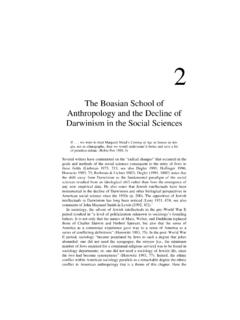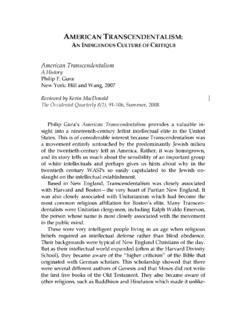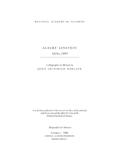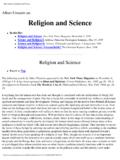Transcription of Preface to the Paperback Edition - Kevin B. …
1 Preface to the Paperback Edition The Culture of Critique (hereafter, CofC) was originally published in 1998 by Praeger Publishers, an imprint of Greenwood Publishing Group, Inc. The thesis of the book is a difficult one indeed difficult not only because it is difficult to establish, but also because it challenges many fundamental as-sumptions about our contemporary intellectual and political existence. CofC describes how Jewish intellectuals initiated and advanced a number of important intellectual and political movements during the 20th century. I argue that these movements are attempts to alter Western societies in a manner that would neutralize or end anti-Semitism and enhance the prospects for Jewish group continuity either in an overt or in a semi-cryptic manner. Several of these Jewish movements ( , the shift in immigration policy favoring non-European peoples) have attempted to weaken the power of their perceived competitors the European peoples who early in the 20th century had as-sumed a dominant position not only in their traditional homelands in Europe, but also in the United States, Canada, and Australia.
2 At a theoretical level, these movements are viewed as the outcome of conflicts of interest between Jews and non-Jews in the construction of culture and in various public policy issues. Ultimately, these movements are viewed as the expression of a group evolutionary strategy by Jews in their competition for social, political and cultural dominance with non-Jews. Here I attempt to answer some typical criticisms that have been leveled against CofC. (See also my website: ~kmacd). I also discuss issues raised by several books that have appeared since the publication of CofC. There have been complaints that I am viewing Judaism in a monolithic manner. This is definitely not the case. Rather, in each movement that I discuss, my methodology has been: (1.) Find influential movements dominated by Jews, with no implication that all or most Jews are involved in these movements and no restrictions on what the movements are.
3 For example, I touch on Jewish neo-conservatism which is a departure in some ways from the other movements I discuss. In general, relatively few Jews were involved in most of these movements and significant numbers of Jews may have been unaware of their existence. Even Jewish leftist radicalism surely the most widespread and influential Jewish sub-culture of the 20th century may have been a minority movement within Jewish communities in the United States and other Western societies for most periods. As a result, when I criticize these movements I am not necessarily criticizing most Jews. Nevertheless, these movements were influential and they were Jewishly motivated. (2.) Determine whether the Jewish participants in those movements identi-fied as Jews AND thought of their involvement in the movement as advancing specific Jewish interests. Involvement may be unconscious or involve self-deception, but for the most part it was quite easy and straightforward to find The Culture of Critique ii evidence for these propositions.
4 If I thought that self-deception was important (as in the case of many Jewish radicals), I provided evidence that in fact they did identify as Jews and were deeply concerned about Jewish issues despite surface appearances to the contrary. (See also Ch. 1 of CofC.) (3.) Try to gauge the influence of these movements on gentile society. Keep in mind that the influence of an intellectual or political movement dominated by Jews is independent of the percentage of the Jewish community that is involved in the movement or supports the movement. (4.) Try to show how non-Jews responded to these movements for exam-ple, were they a source of anti-Semitism? Several of the movements I discuss have been very influential in the social sciences. However, I do not argue that there are no Jews who do good social science, and in fact I provide a list of prominent Jewish social scientists who in my opinion do not meet the conditions outlined under (2) above (see Ch.)
5 2 of CofC). If there was evidence that these social scientists identified as Jews and had a Jewish agenda in doing social science (definitely not in the case of most of those listed, but possibly true in the case of Richard Herrnstein see below), then they would have been candidates for inclusion in the book. The people I cite as contributing to evolutionary/biological perspectives are indeed ethnically Jewish, but for most of them I have no idea whether they either identity as Jews or if they have a Jewish agenda in pursuing their research simply because there is no evidence to be found in their work or elsewhere. If there is evidence that a prominent evolutionary biologist identifies as a Jew and views his work in sociobiology or evolutionary psychology as advancing Jewish agendas, then he or she should have been in CofC as an example of the phenomenon under study rather than as simply a scientist working in the area of evolutionary studies.
6 Interestingly, in the case of one of those I mention, Richard J. Herrnstein, Alan Ryan (1994, 11) writes, Herrnstein essentially wants the world in which clever Jewish kids or their equivalent make their way out of their humble backgrounds and end up running Goldman Sachs or the Harvard physics department. This is a stance that is typical, I suppose, of neo-conservatism, a Jewish movement I discuss in several places, and it is the sort of thing that, if true, would suggest that Herrnstein did perceive the issues discussed in The Bell Curve as affecting Jewish interests in a way that Charles Murray, his co-author, did not. (Ryan contrasts Murray s and Herrnstein s world views: Murray wants the Midwest in which he grew up a world in which the local mechanic didn t care two cents whether he was or wasn t brighter than the local math teacher. ) Similarly, 20th-century theoretical physics does not qualify as a Jewish intellectual movement precisely because it was good science and there are no signs of ethnic involvement in its creation: Jewish identification and pursuit of Jewish interests were not important to the content of the theories or to the conduct of the intellectual movement.
7 Yet Jews have been heavily overrepresented among the ranks of theoretical physicists. Preface to the First Paperback Edition iii This conclusion remains true even though einstein , the leading figure among Jewish physicists, was a strongly motivated Zionist (F lsing 1997, 494 505), opposed assimilation as a contemptible form of mimicry (p. 490), preferred to mix with other Jews whom he referred to as his tribal compan-ions (p. 489), embraced the uncritical support for the Bolshevik regime in Russia typical of so many Jews during the 1920s and 1930s, including persis-tent apology for the Moscow show trials in the 1930s (pp. 644 5), and switched from a high-minded pacifism during World War I, when Jewish interests were not at stake, to advocating the building of atomic bombs to defeat Hitler. From his teenage years he disliked the Germans and in later life criticized Jewish colleagues for converting to Christianity and acting like Prussians.
8 He especially disliked Prussians, who were the elite ethnic group in Germany. Reviewing his life at age 73, einstein declared his ethnic affiliation in no uncertain terms: My relationship with Jewry had become my strongest human tie once I achieved complete clarity about our precarious position among the nations (in F lsing 1997, 488). According to F lsing, einstein had begun developing this clarity from an early age, but did not acknowledge it until much later, a form of self-deception: As a young man with bourgeois-liberal views and a belief in enlightenment, he had refused to acknowledge [his Jewish identity] (in F lsing 1997, 488). In other words, the issues of the ethnic identification and even ethnic activ-ism on the part of people like einstein are entirely separate from the issue of whether such people viewed the content of the theories themselves as further-ing ethnic interests, and, in the case of einstein , there is no evidence that he did so.
9 The same cannot be said for Freud, the New York Intellectuals, the Boasians, and the Frankfurt School, in which scientific theories were fashioned and deployed to advance ethnic group interests. This ideological purpose becomes clear when the unscientific nature of these movements is understood. Much of the discussion in CofC documented the intellectual dishonesty, the lack of empirical rigor, the obvious political and ethnic moti-vation, the expulsion of dissenters, the collusion among co-ethnics to domi-nate intellectual discourse, and the general lack of scientific spirit that pervaded them. In my view, the scientific weakness of these movements is evidence of their group-strategic function. CofC was not reviewed widely. Indeed, only three reviews have appeared in mainstream publications, including a brief review by Kevin Hannan (2000) in Nationalities Papers.
10 Hannan s review mostly describes the book, but he summarizes his impressions by noting, [MacDonald s] iconoclastic evalua-tion of psychoanalysis, Marxism, multiculturalism, and certain schools of thought in the social sciences will not generate great enthusiasm for his work in academe, yet this book is well written and has much to offer the reader interested in ethnicity and ethnic conflict. The other reviews have raised several important issues that bear discussion. Frank Salter s (2000) review in Human Ethology Bulletin discussed some of the controversy surrounding my work, particularly an acrimonious session at The Culture of Critique iv the 2000 conference of the Human Behavior and Evolution Society where I was accused of anti-Semitism by several participants. For me the only issue is whether I have been honest in my treatment of sources and whether my conclusions meet the usual standards of scholarly research in the social sci-ences.












